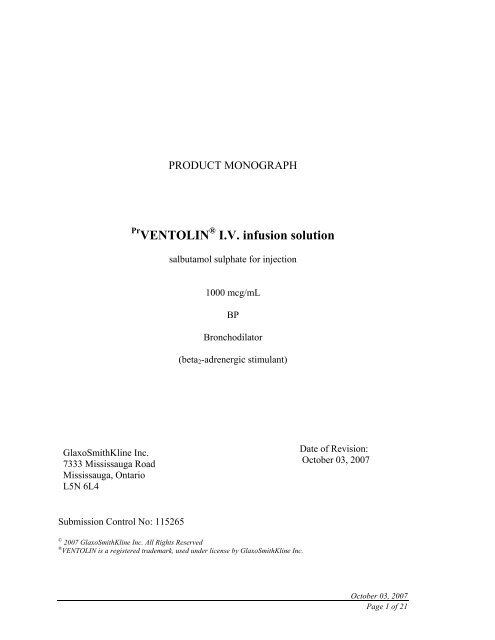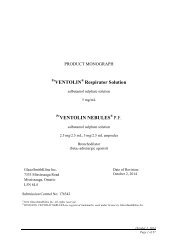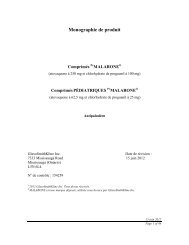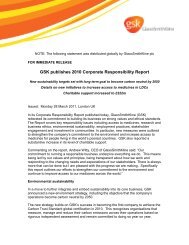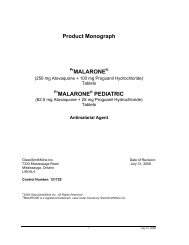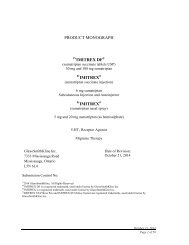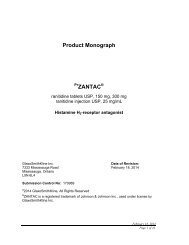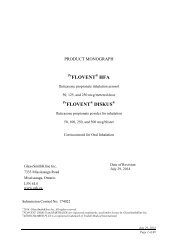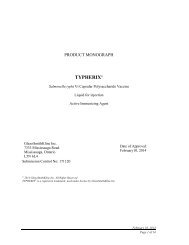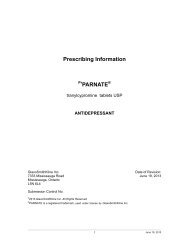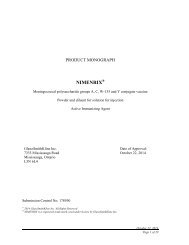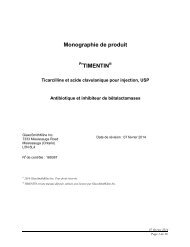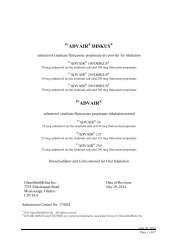VENTOLIN I.V. infusion solution - GlaxoSmithKline
VENTOLIN I.V. infusion solution - GlaxoSmithKline
VENTOLIN I.V. infusion solution - GlaxoSmithKline
Create successful ePaper yourself
Turn your PDF publications into a flip-book with our unique Google optimized e-Paper software.
PRODUCT MONOGRAPH<br />
Pr <strong>VENTOLIN</strong> ® I.V. <strong>infusion</strong> <strong>solution</strong><br />
salbutamol sulphate for injection<br />
1000 mcg/mL<br />
BP<br />
Bronchodilator<br />
(beta 2 -adrenergic stimulant)<br />
<strong>GlaxoSmithKline</strong> Inc.<br />
7333 Mississauga Road<br />
Mississauga, Ontario<br />
L5N 6L4<br />
Date of Revision:<br />
October 03, 2007<br />
Submission Control No: 115265<br />
© 2007 <strong>GlaxoSmithKline</strong> Inc. All Rights Reserved<br />
® <strong>VENTOLIN</strong> is a registered trademark, used under license by <strong>GlaxoSmithKline</strong> Inc.<br />
October 03, 2007<br />
Page 1 of 21
Table of Contents<br />
PART I: HEALTH PROFESSIONAL INFORMATION.........................................................3<br />
SUMMARY PRODUCT INFORMATION ........................................................................3<br />
INDICATIONS AND CLINICAL USE..............................................................................3<br />
CONTRAINDICATIONS ...................................................................................................3<br />
WARNINGS AND PRECAUTIONS..................................................................................4<br />
ADVERSE REACTIONS....................................................................................................7<br />
DRUG INTERACTIONS ....................................................................................................8<br />
DOSAGE AND ADMINISTRATION................................................................................9<br />
OVERDOSAGE ................................................................................................................10<br />
ACTION AND CLINICAL PHARMACOLOGY ............................................................10<br />
STORAGE AND STABILITY..........................................................................................10<br />
DOSAGE FORMS, COMPOSITION AND PACKAGING .............................................10<br />
PART II: SCIENTIFIC INFORMATION ...............................................................................11<br />
PHARMACEUTICAL INFORMATION..........................................................................11<br />
DETAILED PHARMACOLOGY.....................................................................................12<br />
TOXICOLOGY .................................................................................................................13<br />
REFERENCES ..................................................................................................................16<br />
PART III: CONSUMER INFORMATION..............................................................................19<br />
October 03, 2007<br />
Page 2 of 21
Pr <strong>VENTOLIN</strong><br />
®<br />
I.V. <strong>infusion</strong> <strong>solution</strong><br />
salbutamol sulphate for injection<br />
PART I: HEALTH PROFESSIONAL INFORMATION<br />
SUMMARY PRODUCT INFORMATION<br />
Route of<br />
Administration<br />
Dosage Form / Strength Clinically Relevant Nonmedicinal<br />
Ingredients<br />
Intravenous (I.V.) salbutamol I.V. Infusion / Not Applicable<br />
1000 mcg/mL<br />
For a complete listing see Dosage Forms, Composition and Packaging section.<br />
INDICATIONS AND CLINICAL USE<br />
<strong>VENTOLIN</strong> ® (salbutamol sulphate) I.V. <strong>infusion</strong> <strong>solution</strong> is indicated for:<br />
• the relief of severe bronchospasm associated with acute exacerbations of chronic<br />
bronchitis and bronchial asthma,<br />
• the treatment of status asthmaticus.<br />
In many patients, <strong>VENTOLIN</strong> ® <strong>infusion</strong> <strong>solution</strong> will be no more effective, and likely<br />
less well tolerated, than <strong>VENTOLIN</strong> ® HFA inhalation aerosol or <strong>VENTOLIN</strong> ® respirator<br />
<strong>solution</strong>. However, patients who are severely ill with airway inflammation and mucus<br />
plugging may respond well to parenteral salbutamol after failing to benefit from the<br />
inhaled drug.<br />
This product should be administered under the supervision of a qualified health<br />
professional who is experienced in the use of parenteral preparations and in the<br />
management of asthma. Appropriate management of therapy and complications is only<br />
possible when adequate diagnostic and treatment facilities are readily available.<br />
CONTRAINDICATIONS<br />
• Patients who are hypersensitive to this drug or to any ingredient in the<br />
formulation or component of the container.<br />
• Patients with cardiac tachyarrhythmias<br />
• Patients at risk of threatened abortion during the first or second trimester.<br />
October 03, 2007<br />
Page 3 of 21
WARNINGS AND PRECAUTIONS<br />
General<br />
<strong>VENTOLIN</strong> ® I.V. <strong>infusion</strong> <strong>solution</strong> may be diluted with Water for Injection BP, Sodium<br />
Chloride Injection BP, Dextrose Injection BP, or Sodium Chloride and Dextrose Injection<br />
BP (see DOSAGE AND ADMINISTRATION). These are the only recommended<br />
diluents. Dextrose-containing <strong>solution</strong>s may not be suitable for patients with diabetes<br />
mellitus, due to the possible danger of glucose overload.<br />
The use of <strong>VENTOLIN</strong> ® <strong>infusion</strong> <strong>solution</strong> in the treatment of severe bronchospasm or<br />
status asthmaticus does not obviate the requirement for glucocorticoid steroid therapy as<br />
appropriate. When practicable, administration of oxygen, concurrently with<br />
<strong>VENTOLIN</strong> ® <strong>infusion</strong> <strong>solution</strong> is recommended, particularly when salbutamol is given<br />
by intravenous <strong>infusion</strong> to hypoxic patients.<br />
Cardiovascular<br />
In individual patients, any beta 2 -adrenergic agonist, including salbutamol, may have a<br />
clinically significant cardiac effect. Care should be taken with patients suffering from<br />
cardiovascular disorders, especially coronary insufficiency, cardiac arrhythmias and<br />
hypertension. Special care and supervision are required in patients with idiopathic<br />
hypertrophic subvalvular aortic stenosis, in whom an increase in the pressure gradient<br />
between the left ventricle and the aorta may occur, causing increased strain on the left<br />
ventricle.<br />
Fatalities have been reported following excessive use of inhaled sympathomimetic drugs<br />
in patients with asthma. The exact cause of death is unknown, but cardiac arrest<br />
following an unexpected development of a severe acute asthmatic crisis and subsequent<br />
hypoxia is suspected.<br />
Endocrine and Metabolism<br />
Metabolic Effects<br />
In common with other beta-adrenergic agents, salbutamol can induce reversible<br />
metabolic changes, such as potentially serious hypokalemia, particularly following<br />
nebulised or especially infused administration. Particular caution is advised in acute<br />
severe asthma since hypokalemia may be potentiated by concomitant treatment with<br />
xanthine derivatives, steroids and diuretics, and by hypoxia. Hypokalemia will increase<br />
the susceptibility of digitalis-treated patients to cardiac arrythmias. It is recommended<br />
that serum potassium levels be monitored in such situations.<br />
Large doses of intravenous salbutamol have been reported to aggravate pre-existing<br />
diabetes mellitus. The diabetic patient may be unable to compensate for the increased<br />
blood glucose levels and the development of ketoacidosis has been reported. Concurrent<br />
administration of corticosteroids can exaggerate this effect. Diabetic patients and those<br />
October 03, 2007<br />
Page 4 of 21
concurrently receiving corticosteroids should be monitored frequently during intravenous<br />
<strong>infusion</strong> of <strong>VENTOLIN</strong> ® I.V. <strong>infusion</strong> <strong>solution</strong> so that remedial steps (e.g. an increase in<br />
insulin dosage) can be taken to counter any metabolic change that is occurring. For these<br />
patients, <strong>VENTOLIN</strong> ® I.V. <strong>infusion</strong> <strong>solution</strong> should be diluted with Sodium Chloride<br />
Injection BP, rather than Sodium Chloride and Dextrose Injection BP.<br />
Lactic acidosis has been reported very rarely in association with high therapeutic doses of<br />
intravenous and nebulised short-acting beta-agonist therapy, mainly in patients being<br />
treated for an acute asthma exacerbation (see Adverse Reaction section). Increase in<br />
lactate levels may lead to dyspnea and compensatory hyperventilation, which could be<br />
misinterpreted as a sign of asthma treatment failure and lead to inappropriate<br />
intensification of short-acting beta-agonist treatment. It is therefore recommended that<br />
patients are monitored for the development of elevated serum lactate and consequent<br />
metabolic acidosis in this setting.<br />
Care should be taken with patients with hyperthyroidism.<br />
Hypersensitivity<br />
Immediate hypersensitivity reactions may occur after administration of salbutamol, as<br />
demonstrated by rare cases of urticaria, angioedema, rash, bronchospasm, hypotension,<br />
anaphylaxis and oropharyngeal edema.<br />
Care should be taken in patients who are unusually responsive to sympathomimetic<br />
amines.<br />
Neurologic<br />
Care should be taken with patients with convulsive disorders.<br />
Respiratory<br />
Some patients have been reported to have developed severe paradoxical bronchospasm<br />
with repeated excessive use of sympathomimetic inhalation preparations. In this event,<br />
the use of the preparation should be discontinued immediately and alternate therapy<br />
instituted, since in the reported cases the patients did not respond to other forms of<br />
therapy until the drug was withdrawn.<br />
Special Populations<br />
Pregnant Women: Salbutamol, in common with other betamimetics, is not approved to<br />
stop or prevent premature labour.<br />
Due to the risk of pulmonary edema and myocardial ischaemia that has been observed<br />
during the use of betamimetics in the treatment of premature labour, before <strong>VENTOLIN</strong> ®<br />
<strong>infusion</strong> <strong>solution</strong> is given to any patient with known heart disease, an adequate<br />
assessment of the patient’s cardiovascular status should be made by a physician<br />
experienced in cardiology.<br />
October 03, 2007<br />
Page 5 of 21
There are no adequate and well-controlled studies in pregnant women and there is little<br />
published evidence of its safety in the early stages of human pregnancy. Administration<br />
of any drug to pregnant women should only be considered if the anticipated benefits to<br />
the expectant woman are greater than any possible risks to the foetus.<br />
During worldwide marketing experience, rare cases of various congenital anomalies<br />
including cleft palate and limb defects have been reported in the offspring of patients<br />
being treated with salbutamol. Some of the mothers were taking multiple medications<br />
during their pregnancies. Because no consistent pattern of defects can be discerned, and<br />
baseline rate for congenital anomalies is 2-3%, a relationship with salbutamol use cannot<br />
be established.<br />
Labour and Delivery: It has been reported that high doses of salbutamol, administered<br />
intravenously, inhibit uterine contractions.<br />
Therefore, cautious use of <strong>VENTOLIN</strong> ® <strong>infusion</strong> <strong>solution</strong> is required in pregnant patients<br />
when it is given for relief of bronchospasm so as to avoid interference with uterine<br />
contractibility. During I.V. <strong>infusion</strong> of salbutamol, the maternal pulse rate should be<br />
monitored and not normally allowed to exceed a steady rate of 140 beats per minute.<br />
As maternal pulmonary edema and myocardial ischaemia have been reported during or<br />
following premature labour in patients receiving beta 2 -agonists, careful attention should<br />
be given to fluid balance and cardio-respiratory function, including ECG, should be<br />
monitored. If signs of pulmonary edema or myocardial ischaemia develop,<br />
discontinuation of treatment should be considered (see Adverse Reactions).<br />
Nursing Women: As salbutamol is probably secreted in breast milk and because of the<br />
potential for tumorigenicity of salbutamol shown in some animal studies, a decision<br />
should be made whether to discontinue nursing or to discontinue the drug, taking into<br />
account the importance of the drug to the mother. It is not known whether salbutamol<br />
has a harmful effect on the neonate.<br />
Pediatrics: The dosage of <strong>VENTOLIN</strong> ® <strong>infusion</strong> <strong>solution</strong> in the pediatric age group has<br />
not been established. At present there are insufficient data to recommend a dosage<br />
regimen for use in children.<br />
Monitoring and Laboratory Tests<br />
In accordance with the present practice for asthma treatment, patient response should be<br />
monitored clinically and by lung function tests.<br />
Electrocardiogram, and serum potassium and glucose should be monitored during<br />
continuous <strong>infusion</strong>s of salbutamol.<br />
Monitoring and Control of Asthma<br />
Failure to respond to a previously effective dose of salbutamol indicates a deterioration of<br />
the condition and the physician should be contacted promptly.<br />
October 03, 2007<br />
Page 6 of 21
In worsening asthma it is inadequate to increase beta 2 -agonist use only, especially over an<br />
extended period of time. Instead, a reassessment of the patient’s therapy plan is required<br />
and concomitant anti inflammatory therapy should be considered. Sudden or progressive<br />
deterioration in asthma control is potentially life threatening; the treatment plan must be<br />
re-evaluated, and consideration be given to corticosteroid therapy.<br />
ADVERSE REACTIONS<br />
Adverse Drug Reaction Overview<br />
Fine muscle tremor is a common side effect of <strong>VENTOLIN</strong> ® <strong>infusion</strong> <strong>solution</strong>. This is<br />
due to direct beta 2 -stimulation by salbutamol of skeletal muscle. There have been very<br />
rare reports of transient muscle cramps.<br />
A dose-dependent increase in heart rate, secondary to a reduction in peripheral resistance,<br />
due to vasodilation, may occur with parenteral salbutamol, and may cause palpitations.<br />
This is most likely to occur in patients with normal heart rates. In patients with preexisting<br />
sinus tachycardia, especially those in status asthmaticus, the heart rate tends to<br />
fall as the condition of the patient improves. Cardiac arrhythmias (including atrial<br />
fibrillation, supraventricular tachycardia and extrasystoles) have been reported, usually in<br />
susceptible patients.<br />
In the management of pre-term labour, salbutamol <strong>solution</strong> for <strong>infusion</strong> has uncommonly<br />
been associated with pulmonary edema and myocardial ischaemia. Patients with<br />
predisposing factors including multiple pregnancies, fluid overload, maternal infection<br />
and pre-eclampsia may have an increased risk of developing pulmonary edema.<br />
Paradoxical bronchospasm has been reported to occur following salbutamol inhalation<br />
therapy, requiring the immediate discontinuation of the drug and the institution of<br />
alternative forms of therapy. As with other beta 2 -agonists, hyperactivity has been<br />
reported rarely in children.<br />
Potentially serious hypokalemia may result from beta 2 -agonist therapy, mainly from<br />
parenteral and nebulised administration.<br />
Other side effects which may occur with salbutamol are sweating, headache, dizziness,<br />
flushing, nausea, vomiting, muscle cramps, insomnia, drowsiness, restlessness,<br />
irritability, chest discomfort, difficulty in micturition, hypertension, angina, vertigo,<br />
central nervous system stimulation, unusual taste and drying or irritation of the<br />
oropharynx.<br />
Immediate hypersensitivity reactions including angioedema, urticaria, bronchospasm,<br />
hypotension, rash, oropharyngeal oedema, anaphylaxis and collapse have been reported<br />
very rarely.<br />
October 03, 2007<br />
Page 7 of 21
Lactic acidosis has also been reported very rarely in patients receiving intravenous<br />
salbutamol therapy for the treatment of acute asthma exacerbation.<br />
DRUG INTERACTIONS<br />
Drug-Drug Interactions<br />
Table 1: Established or Potential Drug-Drug Interactions<br />
salbutamol sulphate Ref Effect Clinical comment<br />
Monoamine oxidase<br />
inhibitors or tricyclic<br />
antideprssants.<br />
Other sympathomimetic<br />
bronchodilators or<br />
epinephrine.<br />
CS<br />
CS<br />
May potentiate action of<br />
salbutamol on<br />
cardiovascular system.<br />
May lead to deleterious<br />
cardiovascular effects.<br />
Beta-blockers CS May effectively antagonise<br />
the action of salbutamol.<br />
Diuretics CS May lead to ECG changes<br />
and/or hypokalemia,<br />
although the clinical<br />
significance of these<br />
effects is not known.<br />
Digoxin CS May lead to mean decrease<br />
in serum digoxin levels.<br />
The clinical significance of<br />
these findings for patients<br />
with obstructive airways<br />
disease who are receiving<br />
salbutamol and digoxin on<br />
a chronic basis is unclear.<br />
Legend CS = Class Statement<br />
Salbutamol should be administered with<br />
extreme caution to patients being treated<br />
with monoamine oxidase inhibitors or<br />
tricyclic antidepressants.<br />
Other sympathomimetic bronchodilators or<br />
epinephrine should not be used<br />
concomitantly with salbutamol. If<br />
additional adrenergic drugs are to be<br />
administered by any route to the patient<br />
using salbutamol, the adrenergic drugs<br />
should be used with caution to avoid<br />
deleterious cardiovascular effects. Such<br />
concomitant use must be individualised<br />
and not given on a routine basis. If regular<br />
co-administration is required then<br />
alternative therapy must be considered.<br />
Beta-adrenergic blocking drugs, especially<br />
the non-cardioselective ones, such as<br />
propranolol, should not usually be<br />
prescribed together.<br />
The ECG changes and/or hypokalemia that<br />
may result from the administration of nonpotassium<br />
sparing diuretics (such as loop<br />
or thiazide diuretics) can be acutely<br />
worsened by beta-agonists, especially<br />
when the recommended dose of the betaagonist<br />
is exceeded. Caution is advised in<br />
the co-administration of beta-agonists with<br />
non-potassium sparing diuretics.<br />
Mean decreases of 16-22% in serum<br />
digoxin levels were demonstrated after<br />
single doses intravenous and oral<br />
administration of salbutamol, respectively,<br />
to normal volunteers who had received<br />
digoxin for 10 days. It would be prudent<br />
to carefully evaluate serum digoxin levels<br />
in patients who are currently receiving<br />
digoxin and salbutamol.<br />
October 03, 2007<br />
Page 8 of 21
DOSAGE AND ADMINISTRATION<br />
Recommended Dose and Dosage Adjustment<br />
Adults<br />
In severe bronchospasm and status asthmaticus<br />
Continuous intravenous <strong>infusion</strong><br />
5 micrograms/min., increased to 10 micrograms/min., and 20 micrograms/min. at 15 - 30<br />
minute intervals, if necessary. A suitable <strong>solution</strong> for <strong>infusion</strong> may be prepared by<br />
diluting 5 mL of <strong>VENTOLIN</strong> ® I.V. <strong>infusion</strong> <strong>solution</strong> (1.0 mg/mL) in 500 mL of a chosen<br />
i.v. <strong>solution</strong> to provide a salbutamol concentration of 10 micrograms/mL.<br />
<strong>VENTOLIN</strong> ® I.V. INFUSION SOLUTION MUST NOT BE INJECTED UNDILUTED.<br />
THE CONCENTRATION SHOULD BE REDUCED 50% BEFORE<br />
ADMINISTRATION. <strong>VENTOLIN</strong> ® <strong>infusion</strong> <strong>solution</strong> is compatible in PVC bags and in<br />
glass bottles with Water for Injection BP, Sodium Chloride Injection BP, Dextrose<br />
Injection BP, and Sodium Chloride and Dextrose Injection BP. Dextrose-containing<br />
<strong>solution</strong>s may not be suitable for patients with diabetes mellitus due to the possible<br />
danger of glucose overload (see WARNINGS AND PRECAUTIONS).<br />
Children<br />
The dosage of <strong>VENTOLIN</strong> ® <strong>infusion</strong> <strong>solution</strong> in the pediatric age group has not been<br />
established. At present, there are insufficient data to recommend a dosage regimen for<br />
children.<br />
Administration<br />
<strong>VENTOLIN</strong> ® <strong>infusion</strong> <strong>solution</strong> is not to be administered with other medication as part of<br />
the same <strong>infusion</strong>.<br />
Continuous intravenous <strong>infusion</strong>, when practicable, is the preferred method of<br />
administration.<br />
Reconstituted Solutions:<strong>VENTOLIN</strong> ® <strong>infusion</strong> <strong>solution</strong> may be diluted with Water for<br />
Injection BP, Sodium Chloride Injection BP, Sodium Chloride and Dextrose Injection BP<br />
or Dextrose Injection BP. These are the only recommended diluents.<br />
As with all parenteral drug products, intravenous admixtures should be inspected visually<br />
for clarity, particulate matter, precipitate, discoloration and leakage prior to<br />
administration, whenever <strong>solution</strong> and container permit.<br />
All unused admixtures of <strong>VENTOLIN</strong> ® <strong>infusion</strong> <strong>solution</strong> with <strong>infusion</strong> fluids should be<br />
discarded 24 hours after preparation.<br />
October 03, 2007<br />
Page 9 of 21
OVERDOSAGE<br />
Symptoms and signs<br />
The most common signs and symptoms of overdose with salbutamol are transient beta<br />
agonist pharmacologically mediated events (see Warning and Precautions and Adverse<br />
Reactions). Overdosage may cause tachycardia, cardiac arrhythmia, hypokalemia,<br />
hypertension and, in extreme cases, sudden death. Serum potassium levels should be<br />
monitored.<br />
Nausea, vomiting and hyperglycaemia have been reported, predominantly in children and<br />
when salbutamol overdose has been taken via the oral route.<br />
Treatment<br />
Consideration should be given to discontinuation of treatment and appropriate<br />
symptomatic therapy. To antagonise the effect of salbutamol, the judicious use of a<br />
cardioselective beta-adrenergic blocking agent (e.g. metoprolol, atenolol) may be<br />
considered, bearing in mind the danger of inducing an asthmatic attack.<br />
ACTION AND CLINICAL PHARMACOLOGY<br />
Mechanism of Action<br />
Salbutamol produces bronchodilation through stimulation of beta 2 -adrenergic receptors in<br />
bronchial smooth muscle, thereby causing relaxation of bronchial muscle fibers. This<br />
action is manifested by an improvement in pulmonary function as demonstrated by<br />
spirometric measurements.<br />
STORAGE AND STABILITY<br />
<strong>VENTOLIN</strong> ® <strong>infusion</strong> <strong>solution</strong> should be protected from light and stored at controlled<br />
room temperature (15 - 30°C).<br />
DOSAGE FORMS, COMPOSITION AND PACKAGING<br />
<strong>VENTOLIN</strong> ® I.V. <strong>infusion</strong> <strong>solution</strong> 5 mg in 5 mL (1000 micrograms/mL) is presented as<br />
ampoules of 5 mL each containing 5 mg salbutamol as salbutamol sulphate, in a sterile<br />
isotonic <strong>solution</strong> adjusted to pH 3.5 with sulphuric acid and/or sodium hydroxide.<br />
The ampoules are of clear, neutral glass. The <strong>solution</strong> is clear, colourless to pale straw<br />
coloured.<br />
October 03, 2007<br />
Page 10 of 21
PART II: SCIENTIFIC INFORMATION<br />
PHARMACEUTICAL INFORMATION<br />
Drug Substance<br />
Proper name:<br />
Chemical name:<br />
salbutamol sulphate<br />
α 1 -[(tert-butylamino)methyl]-4-hydroxy-m-xylene-α, α’-diol<br />
sulphate (2:1) (salt)<br />
Molecular formula and molecular mass: [C 13 H 21 NO 3 ] 2 •H 2 SO 4 576.71<br />
Structural formula:<br />
Physicochemical properties:<br />
Description:<br />
Solubility:<br />
pH value:<br />
White or almost white powder. It is odourless or<br />
almost odourless.<br />
Salbutamol sulphate is soluble in 4 parts of water;<br />
slightly soluble in ethanol (96%), in chloroform and<br />
in ether.<br />
A 5% <strong>solution</strong> of salbutamol sulphate in distilled<br />
water has a pH value of 4.3<br />
pKa values: Salbutamol has pKa values of 9.3 and 10.3.<br />
Melting Point:<br />
Salbutamol melts at approximately 155 o C, with<br />
decomposition.<br />
<strong>VENTOLIN</strong> ® I.V. <strong>infusion</strong> <strong>solution</strong>: Salbutamol (1000 mcg/mL as salbutamol sulphate);<br />
Sodium chloride (8.8 mg/mL); Sulphuric acid (5% v/v) and/or sodium hydroxide, for pH<br />
adjustment; Water for Injection.<br />
October 03, 2007<br />
Page 11 of 21
DETAILED PHARMACOLOGY<br />
Animal<br />
Salbutamol exerts a relatively selective action on the beta 2 -adrenergic receptors of the<br />
bronchial and vascular smooth muscles. In anesthetized guinea pigs, salbutamol<br />
completely prevents acetylcholine-induced bronchospasm at the dose of 100 mcg/kg<br />
intravenously.<br />
In anesthetized dogs, salbutamol is one-fifth as potent as isoprenaline in skeletal muscle<br />
vasodilation.<br />
In the isolated atrium preparation of guinea pigs, salbutamol was 500 and 2500 times less<br />
potent than isoprenaline in increasing the rate and force of contraction, respectively.<br />
Administration of salbutamol aerosol at the dose of 250 mcg/mL for one minute to guinea<br />
pigs, prevented acetylocholine-induced bronchospasm without any effect on the heart<br />
rate.<br />
In anesthetized cats and dogs, salbutamol prevented the bronchospasm elicited by vagal<br />
stimulation, without any significant effect on heart rate and blood pressure. Comparative<br />
tests of salbutamol and isoprenaline in isolated dog papillary muscle, guinea pig atrial<br />
muscle and human heart muscle, have shown that the effect of salbutamol on betaadrenergic<br />
receptors in the heart is minimal.<br />
In 6 dogs with right-sided cardiac bypass, salbutamol, given at the dose of 25 mcg/mL,<br />
improved left ventricular efficiency and increased coronary blood flow.<br />
Recent studies in laboratory animals (minipigs, rodents and dogs) recorded the<br />
occurrence of cardiac arrhythmias and sudden deaths (with histologic evidence of<br />
myocardial necrosis) when beta-agonists and methylxanthines were administered<br />
concurrently. The significance of these findings when applied to humans is currently<br />
unknown.<br />
Human<br />
Intravenous salbutamol had approximately one-tenth the positive chronotropic potency of<br />
intravenous isoprenaline.<br />
Salbutamol and isoprenaline were equipotent bronchodilators when given intravenously.<br />
However, 7 times the <strong>infusion</strong> rate of salbutamol was necessary to increase the heart rate<br />
by the same amount as with isoprenaline.<br />
Intravenous salbutamol increased ventilatory response to inhaled CO 2 in both hypoxia<br />
and hyperoxia. There was an increase in heart rate which was most pronounced when<br />
hypoxia was combined with hypercapnia. Plasma potassium was decreased in<br />
association with an increase in plasma glucose and serum insulin.<br />
October 03, 2007<br />
Page 12 of 21
Intravenous salbutamol raised the blood levels of insulin, non-esterified fatty acids,<br />
glucose, lactate and ketone bodies. Serum potassium, bicarbonate, phosphate, calcium,<br />
magnesium and corticosteroids were lowered.<br />
Aminophylline potentiated the metabolic effects of salbutamol when the two drugs were<br />
infused in combination.<br />
It was found in asthmatic patients that salbutamol, administered orally, by aerosol, or<br />
intravenously, was metabolized to its 4' -O-sulphate ester. Both free salbutamol and the<br />
metabolite were excreted in the urine, the ratio of the two varying with the route of<br />
administration and suggesting that metabolism occurred in the gut and/or the liver.<br />
Pharmacological testing showed that the metabolite had negligible beta-adrenoceptor<br />
stimulant and no blocking activity.<br />
TOXICOLOGY<br />
Acute Toxicity<br />
Intravenous LD 50<br />
Mouse (10)<br />
72 mg/kg<br />
Mouse (10)<br />
60 mg/kg<br />
Oral LD 50<br />
Mouse (10)<br />
> 2000 mg/kg<br />
Rat (10) > 2000 mg/kg<br />
October 03, 2007<br />
Page 13 of 21
Intraperitoneal LD 50 in Rat<br />
Newborn (155)<br />
216 mg/kg<br />
Weanling (100)<br />
524 mg/kg<br />
Six-Weeks Old (90)<br />
437 mg/kg<br />
(Number of animals in brackets)<br />
The rate of respiration in test animals initially increased, but subsequently became<br />
abnormally slow and deep. Death, preceded by convulsions and cyanosis, usually<br />
occurred within four hours after administration.<br />
Rabbits, cats and dogs survived a single oral dose of 50 mg/kg salbutamol.<br />
Intermediate (Four Months) Toxicity<br />
Rat<br />
Salbutamol was given orally from 0.5 mg/kg up to 25 mg/kg daily on an increasing scale.<br />
There were no significant hematological changes except a small increase in hemoglobin<br />
and packed cell volumes. BUN and SGOT values were elevated while blood glucose and<br />
plasma protein levels remained unchanged. Pituitaries had an increased amount of PASpositive<br />
material in the cleft at higher dose levels.<br />
Dog<br />
Salbutamol was given orally from 0.05 mg/kg up to 12.5 mg/kg daily on an increasing<br />
scale. Hemoglobin and packed cell volumes were slightly decreased, particularly at<br />
higher doses. Leukocyte count decreased after 16 weeks of treatment at each dose level.<br />
Platelet count was increased after eight weeks at the highest dose. No significant effects<br />
were seen on biochemical values. The only significant histological change was the<br />
appearance of corpora amylacea in the stomach, attributed to altered mucus secretion.<br />
Inhalation of 1000 mcg of salbutamol aerosol for 3 months did not produce any<br />
morphological changes in lungs, trachea, lymph nodes, liver or heart. Inhalation of<br />
salbutamol dry powder for 30 days in average daily doses of up to 144 mg/day resulted in<br />
the expected pharmacological effects but no apparent compromise of good health. All<br />
animals survived the study and examination of organs and tissues revealed no significant<br />
changes.<br />
October 03, 2007<br />
Page 14 of 21
Long-Term Toxicity<br />
Chronic toxicity studies were carried out in 2 separate centres. Fifty female, Charles<br />
River CD Albino rats received salbutamol orally at 2, 10 and 50 mg/kg/day for<br />
104 weeks; fifty female Charles River CD Sprague-Dawley derived rats received orally<br />
20 mg/kg/day for 50 weeks, and 50 female Charles River Long-Evans rats received<br />
orally, 20 mg/kg/day for 96 weeks. These studies demonstrated a dose-related incidence<br />
of mesovarian leiomyomas. No similar tumors were seen in mice.<br />
Mutagenicity<br />
In vitro tests involving four micro-organisms revealed no mutagenic activity.<br />
Carcinogenicity<br />
In a two-year study in the rat, salbutamol sulphate caused a significant dose-related<br />
increase in the incidence of benign leiomyomas of the mesovarium at doses<br />
corresponding to 111, 555, and 2,800 times the maximum human inhalation dose. In<br />
another study, the effect was blocked by the co-administraton of propranolol. The<br />
relevance of these findings to humans is not known. An 18-month study in mice and a<br />
lifetime study in hamsters revealed no evidence of tumorigenicity.<br />
Teratogenicity Studies<br />
Mouse<br />
Salbutamol has been shown to be teratogenic in mice when given in doses corresponding<br />
to 14 times the human aerosol dose; when given subcutaneusly in doses corresponding to<br />
0.2 times the maximum human (child weighing 21 kg) oral dose; and when given<br />
subcutaneously in doses corresponding to 0.4 times the maximum human oral dose.<br />
A reproduction study in CD-1 mice given salbutamol at doses of 0.025, 0.25, and<br />
2.5 mg/kg subcutaneously, corresponding to 1.4, 14 and 140 times the maximum human<br />
aerosol dose respectively, showed cleft palate formation in 5 of 111 (4.5%) foetuses at<br />
0.25 mg/kg and in 10 of 108 (9.3%) foetuses at 2.5 mg/kg. No cleft palates were<br />
observed at a dose of 0.025 mg/kg salbutamol. Cleft palates occurred in 22 of 72<br />
(30.5%) foetuses treated with 2.5 mg/kg isoprenaline (positive control).<br />
Rat<br />
No adverse effect was seen when salbutamol was given orally at 0.5, 2.32, 10.75 and<br />
50 mg/kg/day throughout pregnancy. When given to 2 consecutive generations at doses<br />
up to 50 mg/kg/day, no adverse effect was observed on the reproductive function of<br />
either male or female rats. The only toxic effect was an increase in neonatal mortality in<br />
the highest dose level group.<br />
Rabbit<br />
Given orally at 0.5, 2.32, and 10.75 mg/kg/day doses, throughout pregnancy, salbutamol<br />
had no adverse effect. A reproduction study in Stride Dutch rabbits revealed<br />
cranioschisis in 7 of 19 (37%) fetuses at 50 mg/kg, corresponding to 78 times the<br />
maximum human oral dose of salbutamol. At the dose of 50 mg/kg/day, it inhibited the<br />
weight gain of the does.<br />
October 03, 2007<br />
Page 15 of 21
REFERENCES<br />
1. Beswick K, Davies J, Davey AJ. A comparison of intravenous aminophylline and<br />
salbutamol in the treatment of severe bronchospasm. Practitioner 1975<br />
Apr;214(1282):561-6.<br />
2. Bloomfield P, Carmichael J, Petrie GR, Jewell NP, Crompton GK. Comparison of<br />
salbutamol given intravenously and by intermittent positive-pressure breathing in<br />
life-threatening asthma. Br Med J 1979 Mar 31;1(6167):848-50.<br />
3. Coady TJ, Stewart CJ, Davis HJ. Determination of the optimum dose of<br />
subcutaneous salbutamol in asthmatic patients. Br J Clin Pharmacol 1976<br />
Apr;3(2):239-42.<br />
4. Crawford SM, Miles DW. Salbutamol and cardiac arrhythmias. Curr Med Res<br />
Opin 1981;7(6):410-5.<br />
5. Evans WV, Monie RD, Crimmins J, Seaton A. Aminophylline, salbutamol and<br />
combined intravenous <strong>infusion</strong>s in acute severe asthma. Br J Dis Chest 1980<br />
Oct;74(4):385-9.<br />
6. Femi-Pearse D, George WO, Ilechukwu ST, Elegbeleye OO, Afonja AO.<br />
Comparison of intravenous aminophylline and salbutamol in severe asthma. Br<br />
Med J 1977 Feb 19;1(6059):491.<br />
7. Fitchett DH, McNicol MW, Riordan JF. Intravenous salbutamol in management<br />
of status asthmaticus. Br Med J 1975 Jan 11;1(5949):53-5.<br />
8. Georg J. The treatment of status asthmaticus. Allergy 1981 May;36(4):219-32.<br />
9. Hambleton G, Stone MJ. Comparison of IV salbutamol with IV aminophylline in<br />
the treatment of severe, acute asthma in childhood. Arch Dis Child 1979<br />
May;54(5):391-2.<br />
10. Handslip PD, Dart AM, Davies BH. Intravenous salbutamol and aminophylline in<br />
asthma: a search for synergy. Thorax 1981 Oct;36(10):741-4.<br />
11. Hetzel MR, Clark TJ. Comparison of intravenous and aerosol salbutamol. Br Med<br />
J 1976 Oct 16;2(6041):919.<br />
12. Ingram J, Gaddie J, Skinner C, Palmer KN. The effect of intramuscular<br />
salbutamol in asthmatics. Br J Clin Pharmacol 1975 Jun;2(3):263-6.<br />
October 03, 2007<br />
Page 16 of 21
13. Jenkins CR, Marlin GE. The metabolic actions of intravenous salbutamol and<br />
aminophylline singly and in combination. Br J Clin Pharmacol 1981<br />
Feb;11(2):197-201.<br />
14. Johnson AJ, Spiro SG, Pidgeon J, Bateman S, Clarke SW. Intravenous <strong>infusion</strong> of<br />
salbutamol in severe acute asthma. Br Med J 1978 Apr 22;1(6119):1013-5.<br />
15. Lawford P, Jones BJ, Milledge JS. Comparison of intravenous and nebulised<br />
salbutamol in initial treatment of severe asthma. Br Med J 1978 Jan<br />
14;1(6105):84.<br />
16. Leitch AG, Clancy LJ, Costello JF, Flenley DC. Effect of intravenous <strong>infusion</strong> of<br />
salbutamol on ventilatory response to carbon dioxide and hypoxia and on heart<br />
rate and plasma potassium in normal men. Br Med J 1976 Feb 14;1(6006):365-7.<br />
17. Lin C, Li Y, McGlotten J, Morton JB, Symchowicz S. Isolation and identification<br />
of the major metabolite of albuterol in human urine. Drug Metab Dispos 1977<br />
May;5(3):234-8.<br />
18. Marlin GE, Turner P. Intravenous treatment with rimiterol and salbutamol in<br />
asthma. Br Med J 1975 Jun 28;2(5973):715-9.<br />
19. May CS, Paterson JW, Spiro SG, Johnson AJ. Effect of intravenous injection of<br />
salbutamol in asthma. Br J Clin Pharmacol 1975 Dec;2(6):495-501.<br />
20. Neville A, Palmer JB, Gaddie J, May CS, Palmer KN, Murchison LE. Metabolic<br />
effects of salbutamol: comparison of aerosol and intravenous administration. Br<br />
Med J 1977 Feb 12;1(6058):413-4.<br />
21. Nogrady SG, Hartley JP, Seaton A. Metabolic effects of intravenous salbutamol<br />
in the course of acute severe asthma. Thorax 1977 Oct;32(5):559-62.<br />
22. Semple PD, Legge JS, Habeshaw T. Intramuscular salbutamol in acute asthma. Br<br />
J Clin Pharmacol 1976 Oct;3(5):935-6.<br />
23. Spiro SG, Johnson AJ. Intravenous <strong>infusion</strong> of salbutamol in the treatment of<br />
asthma. Br J Clin Pharmacol 1975 Dec;2(6):503-8.<br />
24. Thompson P, Friedman M. Intramuscular salbutamol in treatment of acute<br />
exacerbations of childhood asthma. Arch Dis Child 1977 Jul;52(7):551-4.<br />
25. Tribe AE, Wong RM, Robinson JS. A controlled trial of intravenous salbutamol<br />
and aminophylline in acute asthma. Med J Aust 1976 Nov 13;2(20):749-52.<br />
26. Williams S, Seaton A. Intravenous or inhaled salbutamol in severe acute asthma<br />
Thorax 1977 Oct;32(5):555-8.<br />
October 03, 2007<br />
Page 17 of 21
27. Williams SJ, Parrish RW, Seaton A. Comparison of intravenous aminophylline<br />
and salbutamol in severe asthma. Br Med J 1975 Dec 20;4(5998):685.<br />
October 03, 2007<br />
Page 18 of 21
IMPORTANT: PLEASE READ<br />
PART III: CONSUMER INFORMATION<br />
Pr <strong>VENTOLIN</strong> ® I.V. <strong>infusion</strong> <strong>solution</strong><br />
salbutamol sulphate for injection<br />
This leaflet is part III of a three-part "Product Monograph" for<br />
<strong>VENTOLIN</strong> ® I.V. <strong>infusion</strong> <strong>solution</strong> and is designed<br />
specifically for Consumers. This leaflet is a summary and will<br />
not tell you everything about <strong>VENTOLIN</strong> ® I.V. <strong>infusion</strong><br />
<strong>solution</strong>. Contact your doctor or pharmacist if you have any<br />
questions about the drug. Only a doctor can prescribe it for<br />
you.<br />
ABOUT THIS MEDICATION<br />
What the medication is used for:<br />
Your doctor has prescribed a medicine called<br />
<strong>VENTOLIN</strong> ® I.V. <strong>infusion</strong> <strong>solution</strong> for you. It is used to<br />
help breathing problems in:<br />
$ Asthma<br />
$ Other chest illnesses.<br />
<strong>VENTOLIN</strong> ® I.V. <strong>infusion</strong> <strong>solution</strong> must only be<br />
administered by a health professional. It may be injected into<br />
muscle tissue or into a vein. Do not try to use <strong>VENTOLIN</strong> ®<br />
I.V. <strong>infusion</strong> <strong>solution</strong> on your own.<br />
What it does:<br />
Salbutamol is one of a group of medicines called<br />
bronchodilators. Salbutamol relaxes the muscles in the walls<br />
of the small air passages in the lungs. This helps to open up<br />
the airways and so helps to relieve chest tightness, wheezing<br />
and cough so that you can breathe more easily.<br />
When it should not be used:<br />
Do not use <strong>VENTOLIN</strong> ® I.V. <strong>infusion</strong> <strong>solution</strong> if:<br />
$ you are allergic to it or any of the components of its<br />
formulation (see What the important nonmedicinical<br />
ingredients are).<br />
$ your heart beats faster than normal<br />
$ you are at risk of threatened abortion<br />
What the medicinal ingredient is:<br />
<strong>VENTOLIN</strong> ® I.V. <strong>infusion</strong> <strong>solution</strong> contains the active<br />
ingredient, salbutamol sulphate.<br />
What the important nonmedicinal ingredients are:<br />
<strong>VENTOLIN</strong> ® I.V. <strong>infusion</strong> <strong>solution</strong> contains sodium chloride,<br />
sulphuric acid and/or sodium hydroxide.<br />
What dosage forms it comes in:<br />
<strong>VENTOLIN</strong> ® I.V. <strong>infusion</strong> <strong>solution</strong> comes in ampules of<br />
5 mL each containing 5 mg of Salbutamol as Salbutamol<br />
Sulphate.<br />
WARNINGS AND PRECAUTIONS<br />
Before you use <strong>VENTOLIN</strong> ® I.V. <strong>infusion</strong> <strong>solution</strong>, talk to<br />
your doctor or pharmacist if:<br />
• you have ever had to stop taking other medications for this<br />
illness because you were allergic to them or they caused<br />
problems.<br />
• you are having treatment for a thyroid condition.<br />
• you are having treatment for high blood pressure or a heart<br />
problem.<br />
• if you have diabetes.<br />
• if you have a past history of seizures.<br />
• if you are pregnant or breastfeeding.<br />
Rare cases of lactic acidosis (too much lactic acid in the blood)<br />
have been reported in patients receiving high doses of<br />
<strong>VENTOLIN</strong> ® I.V. <strong>infusion</strong> <strong>solution</strong>. If you suffer symptoms<br />
(see Serious Side Effects Table), contact your doctor<br />
immediately.<br />
If you notice that your shortness of breath or wheeze is<br />
becoming worse, tell your doctor as soon as possible. If the<br />
relief of wheezing or chest tightness is not as good as usual, tell<br />
your doctor as soon as possible. It may be that your chest<br />
condition is worsening and you may need to add another type<br />
of medicine to your treatment.<br />
Your doctor may decide not to prescribe this medicine during<br />
the first three months of pregnancy, or if you are breast feeding<br />
a baby. However, there may be circumstances when your<br />
doctor advises you differently.<br />
Labour and delivery<br />
It has been reported that high doses of <strong>VENTOLIN</strong> ®<br />
(salbutamol) injection can slow down labour (uterine<br />
contractions), but <strong>VENTOLIN</strong> ® is not approved for the<br />
treatment of premature labour in Canada. Due to the risk<br />
of heart and circulation side effects (see Side Effects And What<br />
To Do About Them) and so as to avoid interference with<br />
uterine contractions, <strong>VENTOLIN</strong> ® injection should be used<br />
with caution if given to pregnant patients with breathing<br />
problems during labour.<br />
INTERACTIONS WITH THIS MEDICATION<br />
Make sure that your doctor knows what other medicines you<br />
are taking (such as those for depression, allergies, other airwayopening<br />
medications (e.g. other asthma medications), blood<br />
pressure and heart medications, and water pills (diuretics),<br />
etc.), including those you can buy without a prescription as<br />
well as herbal and alternative medicines.<br />
October 03, 2007<br />
Page 19 of 21
IMPORTANT: PLEASE READ<br />
PROPER USE OF THIS MEDICATION<br />
<strong>VENTOLIN</strong> ® I.V. <strong>infusion</strong> <strong>solution</strong> should not be self<br />
administered by an individual. It should be administered<br />
under the supervision of a health professional.<br />
Usual dose:<br />
Continuous intravenous <strong>infusion</strong>:<br />
5 micrograms/min., increased to 10 micrograms/min., and<br />
20 micrograms/min. at 15 - 30 minute intervals, if necessary.<br />
A suitable <strong>solution</strong> for <strong>infusion</strong> may be prepared by diluting<br />
5 mL of <strong>VENTOLIN</strong> ® I.V. <strong>infusion</strong> <strong>solution</strong> (1.0 mg/mL) in<br />
500 mL of a chosen i.v. <strong>solution</strong> to provide a salbutamol<br />
concentration of 10 micrograms/mL.<br />
SIDE EFFECTS AND WHAT TO DO ABOUT THEM<br />
Very occasionally, some people feel a little shaky or have a<br />
headache or notice that their heart is beating a little faster<br />
and/or more forcefully than usual after using <strong>VENTOLIN</strong> ® .<br />
Muscle cramps can occur, although these are quite rare.<br />
These effects usually wear off within a few hours, but you<br />
should tell your doctor as soon as possible. If you have chest<br />
pain, if your heart beat feels irregular, or feel unwell in any<br />
other way or have any symptoms that you do not understand,<br />
you should contact your doctor immediately.<br />
Tell your doctor at once if you develop breathlessness,<br />
wheezing, chest pain or cough as these may be signs of<br />
increased fluid in the lungs (pulmonary edema). Chest pain<br />
may also be a sign of reduced blood supply to the heart<br />
muscle (myocardial ischaemia).<br />
This is not a complete list of side effects. If you have any<br />
unexpected effects after receiving <strong>VENTOLIN</strong> ® I.V. <strong>infusion</strong><br />
<strong>solution</strong>, contact your doctor or pharmacist.<br />
Very<br />
Rare<br />
SERIOUS SIDE EFFECTS, HOW OFTEN THEY<br />
HAPPEN AND WHAT TO DO ABOUT THEM<br />
Symptom/effect<br />
Increased<br />
wheezing or<br />
tightness in the<br />
chest or difficulty<br />
in breathing (sign<br />
of<br />
bronchospasm).<br />
Allergic reactions<br />
(Hypersensitivity)<br />
Swelling of the<br />
eyelids, face, lips,<br />
tongue or throat,<br />
accompanied by<br />
difficulty in<br />
breathing,<br />
speaking or<br />
swallowing (signs<br />
of angioedema).<br />
Skin rash, skin<br />
eruption or other<br />
effect on the skin<br />
or eyes, itching or<br />
fever. Fainting<br />
when the blood<br />
pressure is too<br />
low (sign of<br />
hypotension).<br />
Deep and rapid<br />
breathing,<br />
vomiting,<br />
abdominal pain,<br />
weight loss,<br />
fatigue, malaise<br />
(sign of lactic<br />
acidosis-too<br />
much lactic acid<br />
in the blood)<br />
Talk with your doctor<br />
or pharmacist<br />
Only if In all<br />
severe cases<br />
Stop taking<br />
drug and call<br />
your doctor or<br />
pharmacist*<br />
<br />
<br />
<br />
* If you think you have these side effects, it is important that<br />
you seek medical advice from your doctor immediately.<br />
HOW TO STORE IT<br />
Keep <strong>VENTOLIN</strong> ® I.V. <strong>infusion</strong> <strong>solution</strong> away from light and<br />
store between 15°C and 30°C.<br />
October 03, 2007<br />
Page 20 of 21
IMPORTANT: PLEASE READ<br />
REPORTING SUSPECTED SIDE EFFECTS<br />
To monitor drug safety, Health Canada collects<br />
information on serious and unexpected effects of drugs. If<br />
you suspect you have had a serious or unexpected reaction<br />
to this drug you may notify Health Canada by:<br />
toll-free telephone: 866-234-2345<br />
toll-free fax 866-678-6789<br />
By email: cadrmp@hc-sc.gc.ca<br />
By regular mail:<br />
National AR Centre<br />
Marketed Health Products Safety and Effectiveness<br />
Information Division<br />
Marketed Health Products Directorate<br />
Tunney’s Pasture, AL 0701C<br />
Ottawa ON K1A 0K9<br />
NOTE: Before contacting Health Canada, you should<br />
contact your physician or pharmacist.<br />
MORE INFORMATION<br />
You may need to read this leaflet again. PLEASE DO NOT<br />
THROW IT AWAY until you have finished your medicine.<br />
This document plus the full product monograph, prepared for<br />
health professionals can be obtained by contacting the<br />
sponsor,<br />
<strong>GlaxoSmithKline</strong> Inc.<br />
7333 Mississauga Road<br />
Mississauga, Ontario<br />
L5N 6L4<br />
1-800-387-7374<br />
This leaflet was prepared by <strong>GlaxoSmithKline</strong> Inc.<br />
Last revised: October 03/2007<br />
© 2007 <strong>GlaxoSmithKline</strong> Inc. All Rights Reserved<br />
® <strong>VENTOLIN</strong> is a registered trademark, used under license by<br />
<strong>GlaxoSmithKline</strong> Inc.<br />
October 03, 2007<br />
Page 21 of 21


